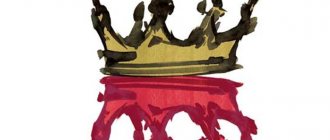Dissociative disorders
This is a whole group of diseases united by the following symptoms and signs:
- impairment of cognitive functions - memory, perception, thinking;
- loss of sense of personal identity;
- changes in consciousness;
- loss of control over your body movements.
The following disorders are classified as dissociative disorders:
- dissociative amnesia;
- fugue;
- depersonalization;
- dissociative identity disorder.
The concept of “dissociation” means splitting off, separation from the whole personality of individual ideas and sensations that are of an unfavorable nature. Normally, it acts as a psychological defense mechanism against negative circumstances.
Everyone knows the feeling “as if this is not happening to me” when a person was in a stressful, traumatic situation. It seems that the experiences experienced exist separately from consciousness. The individual looks at them as an outside observer.
Dissociation for a healthy individual is a useful, necessary protection of the psyche, which helps:
- gather in emotionally difficult, difficult situations;
- look at traumatic events from the outside;
- soberly and impartially assess the current circumstances;
- choose the right solution.
Such protection is included in especially difficult conditions: after suffering physical or sexual violence, disasters, loss of a loved one, severe psychological trauma. Overly impressionable people turn to her more often than usual.
The problem begins when dissociation becomes the main defensive way of experiencing negative emotions, and the defense is activated too often. A person begins to get lost in reality, no longer understanding where his experiences are and where those of others are. This is how dissociative identity disorder develops.
The cause is childhood mental trauma, usually received before the age of 9, or systematic severe emotional blows (violence, stress). However, not every person is susceptible to developing the disease. People with an unbalanced nervous system, easily suggestible, demonstrative, and attention-loving people fall into the risk zone.
Split personality
We perceive a person as an integral system, with an individual set of qualities that interact with each other, helping to find one’s own place in social life and preserve one’s uniqueness. The concept of “face” is associated with personality as the personification of integrity.
With dissociative identity disorder, the patient seems to lose his own identity. Several personalities coexist in it, the number of which is unlimited. Subpersonalities differ in age, gender, profession, character.
The most famous person with a split identity is Billy Milligan, based on whose story Daniel Keyes wrote the book The Many Minds of Billy Milligan. In a man, 24 different subpersonalities coexisted at once. This example explains in detail the essence of the pathology.
Previously, the disease was called obsession. The sufferer was freed from painful bonds by exorcism. Later the disease was called hysteria.
Each of the multiple personality roles is called an ego state. Any of them can be extracted through hypnosis. Initially, it was believed that it was hypnosis that provoked the disorder. This opinion was shared by the French psychiatrist Charcot, who mistook hypnosis for pathology. Subsequently, it was possible to prove the fallacy of this opinion.
Amnesia in DID
In the structure of multiple identity, the main, original personality and alter personalities or ego states are divided. The main personality is the leading one, and she is able to talk about the patient’s past, finding herself in situations created by subpersonalities. But the main personality finds it difficult to talk about the events preceding such a situation. For example, waking up in a hospital bed, the patient does not understand how she ended up here. And the reason for hospitalization was poisoning with pills by another Alter person.
When talking about past events, such a person often violates their chronology and says that he simply does not remember individual episodes. Gaps in memories are explained by banal forgetfulness, and he complains of poor memory.
People with dissociative identity disorder are capable of deliberately withholding certain information and exaggerating existing knowledge in order to hide the fact of the disease.
The patient's story contains contradictory episodes. It seems to outsiders that they are not listening to the narrator attentively or find it difficult to grasp the essence of the story.
The patient's stories about important life events lack detail. The patient knows that he went to school, but it is difficult for him to describe the details of the school period. He says that he does not remember the period, for example, from 6th to 9th grade. It is difficult to remember how the wedding took place, where the celebration was celebrated, and who was invited.
Sometimes the patient reconstructs the picture of important events only from the words of loved ones. Thus, a woman with multiple identities said that she had difficulty remembering her own birthdays, starting from childhood.
Dissociative identity disorder is accompanied by fragmented memories. They manifest themselves under the influence of strong emotions. The patient doubts their reality, stating: I am not sure whether this is true or a figment of my imagination. Time gaps become typical. Let's say the patient sees that the clock shows 8 o'clock in the morning. The next fixed time is 5 pm. But the patient does not remember the interval between this time.
Realize it to the fullest
Surely you have imagined as your alter ego a person whose traits you do not possess. If this is a superhero who is not afraid of anything, you need to learn to become like him. Thoughts are material, so the very desire to become smarter, stronger and or bolder is commendable. Sooner or later you will become such a person without a second “I”. Now start practicing the facial expressions and gestures discussed above. First, you came up with an image, and then completely copied its features and behavior. If it’s difficult, start small (for example, cross your legs the way your second hero does or learn to walk with his gait).
The photographer captured a red-haired girl and her rat, who have been “side by side” for 3 years
Keeping their distance: January was the best month for fitness since the start of the pandemic
“Khaki Resort”: what the actors and creators said about the new TV series
Irrefutable evidence
The presence of a problem is confirmed by certain “evidence”. Often in the wardrobe you find clothes that completely contradict the style of the main personality. It is impossible to remember when and why this item was purchased. The patient, seeing her, is at a loss. Clothes of the opposite sex and the wrong size are shocking. Patients note: not my size, too small, I can’t even pull it on. Or, on the contrary, they find outfits that are oversized. Finding children's things is surprising, especially if there are no children in the house.
Other atypical details are discovered. Women are surprised by the makeup applied, the new hairstyle. They find “other people’s” jewelry, perfume, and wigs in their own apartment. Men go through a similar situation with weapons and cars. The same applies to photographs, drawings, and any personal items.
People suffering from dissociative identity disorder find unfamiliar things in their possessions. As it turns out later, they were stolen. While walking around the supermarket, they are surprised to notice in the basket products that they have not consumed before and did not intend to purchase. Sitting in a cafe, they suddenly wonder when they managed to place an order, why exactly like that.
Fugue-type situations are typical: the patient finds himself in an unfamiliar place and it is not clear to him how he got here. This does not mean moving from room to room (in this case, the feeling of “why did I come here” arises). We are talking about overcoming impressive distances. For example, a person suddenly finds himself in a foreign city. It often happens that the patient systematically ends up in the same place, wondering why he is here. Let's say every morning he finds himself at a certain bus stop, getting on the bus. The situation repeats itself every day, like Groundhog Day.
Personality changes in alcohol addiction
The consequence of alcoholism is changes in the psychophysical and personal status of patients.
When narcologists talk about personality changes due to alcoholism, they mean a certain deformation of human psychology that develops under the influence of addiction. Of course, person is different from person to person, and each alcoholic suffers from this disease in his own way, but still there are specific character traits that are found in almost everyone with alcoholism and are inherent in the alcoholic as a personality type.
Alcoholics are indifferent to their fate, do not have definite plans for the future, and are not touched by the misfortune of loved ones. They get tired quickly and constantly complain of general weakness and poor health. They often lose their previous interests, with the exception of those related to alcohol. The so-called alcoholic character is formed. On the one hand, all emotional reactions (sorrow, joy, dissatisfaction, admiration, etc.) seem to be sharpened due to an increase in general excitability. Then weakness and tearfulness appear, especially when intoxicated.
In other cases, patients become playful and exhibit a tendency to fantastically exaggerate their capabilities and abilities. Often they easily move from a state of extreme recklessness and blind complacency to malice and pickiness. They become intolerant in the team, serve as a constant cause of scandals, and allow physical violence against loved ones. A particularly dramatic change in the personality of alcoholics occurs at the last stage of the disease. Their life is connected with obtaining funds for alcohol and drinking alcohol. Everything else fades into the background. There are no feelings of attachment and duty.
High spirits, carefree and frivolous behavior become characteristic personality traits of the patient. Jokes are often flat, “street” in nature. It is impossible to determine how the patient will behave in a given situation; everything is determined by the “mood of the moment.” Such a trait as lack of will becomes a constant for such patients. The ability for creative work declines sharply. The activities of an alcoholic are dominated by “stamps” of past experience.
The patient cries with joy and grief. On the other hand, emotional hardening occurs. The patient becomes selfish, indifferent towards his wife and children. The sense of duty and responsibility disappears, the meaning of ethical standards of behavior is lost. All the patient’s attention is focused on only one thing - how to get alcohol. Drunkenness is always downplayed, and one's personal qualities are embellished. The patient, as a rule, does not consider himself an alcoholic (or does not admit it to others), arguing that “everyone drinks” and he is “like everyone else.” At first, they find excuses and justifications, looking for reasons to drink. At the same time, they show resourcefulness and deceit in the argumentation of their actions. In the future, the alcoholic no longer hides his desire to drink, drinks in any environment, even if it is not very suitable for this, i.e. situational control is lost. Any means are used to purchase alcoholic beverages. The patient begins to take things from the house, sell them for next to nothing, steal, and beg. The alcoholic humor characteristic of such patients becomes increasingly flat, primitive, and cynical, as is their behavior in general. Brutal (excessive, asocial) forms of reaction appear, such as aggression, malice, violence, and outright cynicism. Increasingly, patients are resorting to the use of surrogates (denatured alcohol, cologne, medicinal tinctures, etc.). The progression of alcoholism is accompanied by social decline.
There are also universal personality changes that are characteristic of all alcoholics: poverty, scarcity of personality, low personal level, decreased creativity and moral values. An alcoholic is coarse, complacent, indifferent to everything except alcohol. His emotional lethargy is permeated with irritability, growing with the desire to drink. This is the similarity of all alcoholics. These changes are based on pronounced damage primarily to the frontal parts of the brain.
Denial of the disease: the inability of alcoholics to fully understand, recognize, and see their personal alcoholic decline; they are critical of their drinking and behavior. Thoughts follow the lead of emotions: one believes in what one wants to believe and vice versa.
Alcohol revival is often very helpful in suspecting alcohol disorders in a sober, gloomy alcoholic. So, as soon as you start talking about the situation of drinking, start talking about the quality of alcohol, which vodka is purer, the alcoholic perks up, begins to fidget, his eyes sparkle, he can swallow saliva and his voice is more friendly, although a minute before it was sluggish, dull, gloomy and did not want to speak.
Alcohol slang: characteristic alcoholic antics, gestures practiced by tireless repetition, body movements: a snap of a finger under the chin, a picture of a shot glass with a hand, a picture of how much to pour, etc.
Over time, personality changes can develop into pronounced alcohol degradation. Memory loss increases and dementia develops. Deceit, sloppiness, loss of moral standards, social degradation are becoming more and more apparent. Alcoholic psychoses are becoming typical. Any drinking can develop into delirium tremens or alcoholic epilepsy.
Tips from the outside
Often the patient learns about pathological “cohabitation” thanks to others. Complete strangers approach him, but they act as if they know the patient well enough, but they call him by a different name. They are having conversations about completely unknown facts. They describe situations that, in their words, they lived with the patient.
People around him talk about actions committed by a person, which he also does not remember. For example, a girl, applying for a new job and working for one day, was eventually refused employment. The reason was aggressive statements and unfounded outbursts of anger, which the employee herself was not aware of. Management and employees informed her about them. Thus, subpersonalities are capable of causing damage to the main personality.
It happens that relatives or acquaintances turn away from a “many-faced” person, show disdain, negativity, and ignore him, in his opinion, completely groundlessly. Subsequently, it turns out that the person, already from the words of his loved ones, behaved incorrectly and spoke insultingly towards someone. But he cannot objectively assess the situation, since inappropriate behavior was manifested by one of the ego states.
Unleash your alter ego
If you have problems that you can’t solve yet, come up with a second story. For example, you are a musician, but you are always embarrassed to appear in public. This is a normal phenomenon among famous people who cannot accept the fact that they need to constantly be public.
Therefore, many of them come up with another character. That is, there are you and a person who goes on stage and performs in some way. This will help you be calm about your performance and show off your talent without wasting energy on anxiety and worry.
The Ministry of Health named the number of countries that have registered the Sputnik V vaccine
It looks festive, but tastes delicious: we are preparing a multi-layer cheesecake
“Revenge is a powerful thing”: she lost weight, deciding to become a beauty to spite her ex (photo)
How alter personalities manifest themselves
An individual can coexist with a variety of ego states in terms of quantity and characteristics. Men and women, children, murderers, prostitutes and saints, housewives and careerists, femme fatales, fictional, biblical characters - anyone, without restrictions. Subpersonalities alternately “switch”, replacing each other, usually without even suspecting the existence of “predecessors”, but sometimes their intersection is possible.
American psychologist and psychiatrist, author of numerous books on these topics, Eric Berne believed that three forms coexist in a person: adult, parent, child. A similar thing can be seen in the multiple personalities of one patient. Some of them come in the form of a child, another - in the form of a caring, instructive parent, the third seeks to protect. Moreover, it happens that they protect not only the main personality, but also the subpersonality, if they know about its presence. This happens when there are more than two ego states.
Returning again to Billy Milligan, since this is a very “successful” example of the symbiosis of multiple images, it is possible to trace the interaction of ego states. One of his subpersonalities is Arthur Smith. Educated, subtle and very smart. He is well versed in medicine. I independently mastered Arabic and Swahili. He logically calculated the presence of other ego states and took patronage over them. He forbade them to manifest themselves, that is, to retain consciousness. So, one of them, Adalina, an affectionate, hardworking lesbian in need of care, warmth and attention, was classified as an undesirable person. Billy did this because it was Adalina who committed the rapes, for which they later tried to bring Billy to trial.
The story of a 20-year-old girl, Doris Fisher, is well known. Five ego states coexisted in her at once: Real Doris, Lethargic Doris, Sick Doris, Margarita, Sleeping Margarita. The latter was vile, constantly committed outrages, spoiled things, even hurt herself. But only Real Doris suffered from this. It was assumed that the disease developed as a result of physical abuse experienced by the girl from her alcoholic father. Doris had an appointment with a psychiatrist, who later took her in. After this, inexplicable things began to happen in his house, which the doctor mistook for a poltergeist. After the doctor's death, Doris was admitted to a psychiatric hospital.
It is often difficult for patients to understand who they are. They feel the presence of several people inside themselves. Feel dependent on external circumstances.
A change in ego states can be noticed by the patient’s appearance. Drooping and trembling of the eyelids, rolling of the eyes, frequent blinking, twitching of the facial muscles, unnatural facial expressions, and grimacing mark the beginning of transformation.
Each of the individual’s subpersonalities is capable of manifesting itself at any moment. Ego states reveal themselves in several ways:
- The voice changes - from barely perceptible notes to obvious ones. If the main and alter personality are of the same gender, then the voice may sound softer or, conversely, abruptly. The halftones may change - become a little higher or lower, slower or faster. The changes are minimal, but overall the voice sounds different. The opposite sex, of course, changes abruptly. The woman suddenly begins to speak in a rough, low, sometimes hoarse voice. A man is more sonorous, taller, more affectionate;
- speech – the appearance of an accent, the use of specific phrases, expressions, expansion or impoverishment of vocabulary, swearing;
- change of handwriting;
- gait, habits, manners. For example, a modest, quiet girl, “shrunken and shrunken,” suddenly transforms – she straightens her shoulders, straightens her posture. Her look, voice, and speech express confidence and dignity. She sits at ease on a chair or walks with a graceful, free gait. Even facial features change. Often new personalities ascribe to themselves the high titles of counts, princes, and call themselves aristocrats. Impersonate famous figures;
- capabilities. The new image, contained in a multifaceted individual, is capable of possessing certain abilities - speaking foreign languages, possessing powerful physical strength, sports skills. From the outside it seems strange when a person who has not previously shown zeal for foreign languages suddenly speaks Latin or Ancient Greek;
- new habits are acquired - smoking, alcohol, food preferences
- call themselves by a different name;
- if a person keeps a diary, then the “outside” Ego can be easily recognized by unfamiliar entries, signatures, drawings, and style. It happens that an alter personality, who has a negative attitude towards the dominant one, leaves obscene entries in the diary.
It is very noticeable when an adult suddenly transforms into a child. His voice and behavior give him away: carelessness, spontaneity. He is either childishly careless, naive and laid-back, or he is scared and hides in the corners. Such a person, who suddenly changes his behavior to a silly, childish one, will instantly attract attention.
Examples from life
Here are some more successful examples of creating an alter ego as an element of the image:
- Vasily Vakulenko. He is known as "Basta". Vasily gained popularity thanks to his lyrical compositions. At one point, he wrote a hooligan song, creating the same image specifically for it. The listeners liked it.
- Ivan Urgant. Everyone knows the famous comedian Ivan Urgant. He has an alter ego - Grisha Urgant, who sings songs as part of a little-known rock band.
- Beyonce. Her alternate image is Sasha Fierce.
Urgant's alter ego
Thus, the concept covers many aspects of human life. These can be either manifestations of mental illness or an image created for a specific purpose.
Not to be confused with schizophrenia
With split personality, as with schizophrenia, symptoms of the first rank according to Schneider occur, so there is a possibility of making a mistake with the diagnosis.
These symptoms include:
- auditory hallucinations – patients with DID report hearing voices in their heads. They argue, swear, shout, criticize the patient, and express aggression. Or, on the contrary, they show favor and encouragement. Evaluate the patient’s thoughts and actions;
- thoughts are under external control. Blocked by external forces;
- imposing other people's thoughts.
Less commonly mentioned is the feeling of openness of thoughts: it seems that outsiders can hear what the patient is thinking about.
With personality dissociative disorder, visual hallucinations are also possible. The patient said that during sexual relations with her husband she saw a dark figure of a man bending over the bed. The woman became very scared. Later the reason became clear: the vision was an echo of childhood. The stepfather sexually abused the girl, and then bent over her bed.









